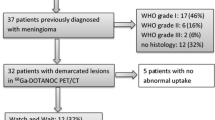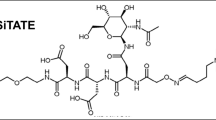Abstract
Purpose
Clinical studies of PET imaging using SSTR2 agonists have demonstrated high accuracy and correlation with SSTR2 expression in meningiomas. However, the usefulness of the SSTR2 antagonist with [68 Ga]Ga-DOTA-JR11 is uncertain. To evaluate the diagnostic performance of [68 Ga]Ga-DOTA-JR11 PET/CT and to clarify tumor characteristics in patients with suspected meningiomas.
Materials and methods
Patients with suspected de novo or recurrent meningioma in complex locations or atypical images were enrolled from August 2021 to October 2022 in prospective study. All patients underwent contrast-enhanced MRI (CE-MRI), [68 Ga]Ga-DOTA-JR11 PET/CT, and histopathological evaluation. Tumor uptake of [68 Ga]Ga-DOTA-JR11 was measured by SUVmax and tumor-endocranium ratio (TBR). Diagnostic performance was compared between PET and MRI.
Results
Of 36 (50.0 ± 13.0 years of age, 20 women) patients, 32 were histopathologically confirmed meningiomas and four with other tumors. [68 Ga]Ga-DOTA-JR11 uptake was significantly higher in meningioma patients than in those with other tumors (SUVmax: 13.6 ± 7.7 vs. 5.2 ± 3.0, P < 0.001; TBR: 64.2 ± 27.7 vs. 25.0 ± 18.9, P = 0.001). [68 Ga]Ga-DOTA-JR11 PET/CT detected 31 meningiomas, while CE-MRI detected 17 meningiomas of 25 initial diagnosis and 11 recurrent tumors; [68 Ga]Ga-DOTA-JR11 PET had an incremental diagnostic value of 24% (6/25) over MRI in the group of initial diagnosis. There was no statistically significant difference in diagnostic efficacy between PET and MRI (P = 0.45) for all 36 patients. In skull base meningiomas, PET provided a more definitive diagnosis of pituitary involvement (in 12, not in12), compared to MRI (in eight, possible in six, possible not in six, not in four). PET revealed bone involvement in all 14 patients proven by pathology, while MRI identified only 11.
Conclusions
[68 Ga]Ga-DOTA-JR11 PET/CT provided high image quality and presented an ideal diagnostic performance in detecting meningioma and evaluating the involvement of the pituitary and bone. The study provides valuable evidence for the use of [68 Ga]Ga-DOTA-JR11 PET/CT as a complementary imaging modality to CE-MRI in the evaluation of meningiomas.




Similar content being viewed by others
Data availability
The datasets generated during and/or analyzed during the current study are available from the corresponding authors on reasonable request.
References
Ostrom QT, Cioffi G, Gittleman H, et al. CBTRUS statistical report: primary brain and other central nervous system tumors diagnosed in the United States in 2012–2016. Neuro Oncol. 2019;21(Suppl 5):v1–100.
Nagai Yamaki V, de Souza Godoy LF, Alencar Bandeira G, et al. Dural-based lesions: is it a meningioma? Neuroradiology. 2021;63(8):1215–25.
Prasad RN, Perlow HK, Bovi J, et al. (68)Ga-DOTATATE PET: the future of meningioma treatment. Int J Radiat Oncol Biol Phys. 2022;113(4):868–71.
Silva CB, Ongaratti BR, Trott G, et al. Expression of somatostatin receptors (SSTR1-SSTR5) in meningiomas and its clinicopathological significance. Int J Clin Exp Pathol. 2015;8(10):13185–92.
Hofman MS, Lau WF, Hicks RJ. Somatostatin receptor imaging with 68Ga DOTATATE PET/CT: clinical utility, normal patterns, pearls, and pitfalls in interpretation. Radiographics. 2015;35(2):500–16.
Purandare NC, Puranik A, Shah S, et al. Differentiating dural metastases from meningioma: role of 68Ga DOTA-NOC PET/CT. Nucl Med Commun. 2020;41(4):356–62.
Afshar-Oromieh A, Giesel FL, Linhart HG, et al. Detection of cranial meningiomas: comparison of 68Ga-DOTATOC PET/CT and contrast-enhanced MRI. Eur J Nucl Med Mol Imaging. 2012;39(9):1409–15.
Rachinger W, Stoecklein VM, Terpolilli NA, et al. Increased 68Ga-DOTATATE uptake in PET imaging discriminates meningioma and tumor-free tissue. J Nucl Med. 2015;56(3):347–53.
Ivanidze J, Roytman M, Lin E, et al. Gallium-68 DOTATATE PET in the evaluation of intracranial meningiomas. J Neuroimaging. 2019;29(5):650–6.
Galldiks N, Albert NL, Sommerauer M, et al. PET imaging in patients with meningioma-report of the RANO/PET Group. Neuro Oncol. 2017;19(12):1576–87.
Goldbrunner R, Stavrinou P, Jenkinson MD, et al. EANO guideline on the diagnosis and management of meningiomas. Neuro Oncol. 2021;23(11):1821–34.
Fani M, Braun F, Waser B, et al. Unexpected sensitivity of sst2 antagonists to N-terminal radiometal modifications. J Nucl Med. 2012;53(9):1481–9.
Cescato R, Erchegyi J, Waser B, et al. Design and in vitro characterization of highly sst2-selective somatostatin antagonists suitable for radiotargeting. J Med Chem. 2008;51(13):4030–7.
Zhu W, Cheng Y, Wang X, et al. Head-to-head comparison of (68)Ga-DOTA-JR11 and (68)Ga-DOTATATE PET/CT in patients with metastatic, well-differentiated neuroendocrine tumors: a prospective study. J Nucl Med. 2020;61(6):897–903.
Nicolas GP, Schreiter N, Kaul F, et al. Sensitivity comparison of (68)Ga-OPS202 and (68)Ga-DOTATOC PET/CT in patients with gastroenteropancreatic neuroendocrine tumors: a prospective phase II imaging study. J Nucl Med. 2018;59(6):915–21.
Albrecht J, Exner S, Grötzinger C, et al. Multimodal imaging of 2-cycle PRRT with (177)Lu-DOTA-JR11 and (177)Lu-DOTATOC in an orthotopic neuroendocrine xenograft tumor mouse model. J Nucl Med. 2021;62(3):393–8.
Dalm SU, Nonnekens J, Doeswijk GN, et al. Comparison of the therapeutic response to treatment with a 177Lu-labeled somatostatin receptor agonist and antagonist in preclinical models. J Nucl Med. 2016;57(2):260–5.
Werner-Wasik M, Nelson AD, Choi W, et al. What is the best way to contour lung tumors on PET scans? Multiobserver validation of a gradient-based method using a NSCLC digital PET phantom. Int J Radiat Oncol Biol Phys. 2012;82(3):1164–71.
Fedorov A, Beichel R, Kalpathy-Cramer J, et al. 3D Slicer as an image computing platform for the Quantitative Imaging Network. Magn Reson Imaging. 2012;30(9):1323–41.
Afshar-Oromieh A, Wolf MB, Kratochwil C, et al. Comparison of 68Ga-DOTATOC-PET/CT and PET/MRI hybrid systems in patients with cranial meningioma: Initial results. Neuro Oncol. 2015;17(2):312–9.
Bikmaz K, Mrak R, Al-Mefty O. Management of bone-invasive, hyperostotic sphenoid wing meningiomas. J Neurosurg. 2007;107(5):905–12.
Zwirner K, Paulsen F, Schittenhelm J, et al. Integrative assessment of brain and bone invasion in meningioma patients. Radiat Oncol. 2019;14(1):132.
Kunz WG, Jungblut LM, Kazmierczak PM, et al. Improved detection of transosseous meningiomas using (68)Ga-DOTATATE PET/CT compared with contrast-enhanced MRI. J Nucl Med. 2017;58(10):1580–7.
Ghosal N, Dadlani R, Gupta K, et al. A clinicopathological study of diagnostically challenging meningioma mimics. J Neurooncol. 2012;106(2):339–52.
Acknowledgements
We are grateful to Xiaoguang Qiu for the valuable suggestion and input during the course of this clinical research.
Funding
This work was supported by the National High Level Hospital Clinical Research Funding (grant number: 2022-PUMCH-B-070) and National Natural Science Foundation of China (grant numbers: 82001778).
Author information
Authors and Affiliations
Contributions
Guarantors of integrity of entire study, all authors; study concepts/study design or data acquisition or data analysis/interpretation, all authors; manuscript drafting or manuscript revision for important intellectual content, all authors; approval of final version of submitted manuscript, all authors; agrees to ensure any questions related to the work are appropriately resolved, all authors; literature research, P.W., S.L., X.L., X.C.; clinical studies, P.W., S.L., X.L., X.L., S.L., Z.W., X.C.; experimental studies, P.W., Z.L., M.J., Y.S.; statistical analysis, P.W., S.L., X.L., Z.W., X.C.; and manuscript editing, P.W., S.L., X.L., X.L., S.L., Z.W., X.C.
Corresponding authors
Ethics declarations
Ethics approval
This study was performed in line with the principles of the Declaration of Helsinki. Approval was granted by the Ethics Committee of Peking Union Medical College Hospital (Date: 27-Apr-2020/No: ZS-1675).
Consent to participate
Written informed consent was obtained from every patient.
Consent to publish
The authors affirm that human research patients provided informed consent for publication of the images in Figs. 2, 3, and 4.
Competing interests
The authors declare no competing interests.
Additional information
Publisher's note
Springer Nature remains neutral with regard to jurisdictional claims in published maps and institutional affiliations.
Rights and permissions
Springer Nature or its licensor (e.g. a society or other partner) holds exclusive rights to this article under a publishing agreement with the author(s) or other rightsholder(s); author self-archiving of the accepted manuscript version of this article is solely governed by the terms of such publishing agreement and applicable law.
About this article
Cite this article
Wang, P., Liu, S., Li, X. et al. The usefulness of [68 Ga]Ga-DOTA-JR11 PET/CT in patients with meningioma: comparison with MRI. Eur J Nucl Med Mol Imaging 51, 218–225 (2023). https://doi.org/10.1007/s00259-023-06391-1
Received:
Accepted:
Published:
Issue Date:
DOI: https://doi.org/10.1007/s00259-023-06391-1




